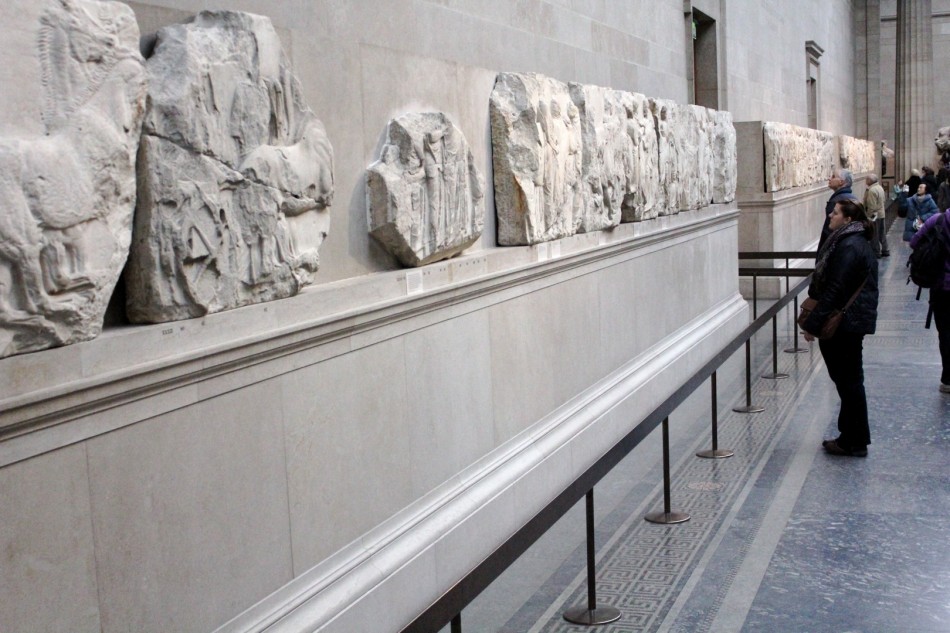Tom Andronas Producer – video | radio | print | photo+61 412 371 466
tomandronas(at)gmail.com
“Historic Propaganda” – Neos Kosmos
 The Parthenon Marbles on display in the British Museum. Photo: Tom Andronas
The Parthenon Marbles on display in the British Museum. Photo: Tom Andronas
THOMAS ANDRONAS
It’s funny, how history can be reinterpreted as a means to an end.
On a recent trip to the British Museum I was astounded to find this iconic educational institution engaged in an overt propaganda campaign aimed at justifying the museum’s ongoing refusal to repatriate the Parthenon Marbles to Greece.
In doing so the museum is actively seeking to paint history in a manner favourable to its position.
Recently in Australia to promote his new book, the Director of the British Museum Neil MacGregor reiterated the museum’s position on the marbles.
“In Athens they can be part of a Greek story and in London they can be part of a world story,” MacGregor told The Australian.
Putting personal opinions on the actual debate aside, I was appalled that the British Museum had engaged in this campaign through the information it provides to the general public.
Information that ought to be objective, factual and free from political rhetoric was in fact, the exact opposite.
The British Museum goes to great lengths to paint Lord Elgin as a conservationist, a protector of antiquity and history, who truly had the interests of historical documentation and education at heart when he removed the marbles from the Parthenon in 1802.
“Elgin’s removal of the sculptures from the ruins of the building has always been a matter for discussion, but one thing is certain – his actions spared them further damage by vandalism, weathering and pollution,” says one information board in the gallery.
The truth of this position is hotly contested.
“Rubbish. Absolute rubbish,” says Emanuel Comino, Founder and Chairman of the International Organising Committee – Australia – for the Restitution of the Parthenon Marbles.
“[Elgin’s] original thought was to decorate his mansion in Scotland, not to save [the marbles] from barbarism or from pollution – there was no pollution in those days,” Comino says.
Another information board makes a brazen attempt to lift the historical cloud over Lord Elgin’s actions by branding him a rescuer.
“The second film concentrates on South Metope IV with its scene of a human Lapith fighting a Centaur, a creature that is part-man part-horse. It tells the story of the metope and the damage that it suffered before it was rescued by Lord Elgin.”
Of course, Emanuel Comino has an alternative view.
“[Elgin] actually raped the Parthenon. He didn’t just remove [the marbles], in order to take them out he had to damage the building immensely and the sculptures themselves in the process,” he says.
Reading between the lines of an information pamphlet covering the conflict surrounding the marbles, the British Museum continues its canonization of Lord Elgin while taking a thinly veiled swipe at the Greek authorities.
“Recently the Greek authorities have continued the process of removing the sculptures from the Parthenon, work that was begun over 200 years ago by Elgin.”
“It is also thanks to Elgin that generations of visitors have been able to see the sculptures at eye level rather than high up on the building,” another board reads.
“It’s not correct,” responds Comino.
“First of all they were not made to be looked at at eye level. The 160-metre-long frieze on the Parthenon was up high in a narrow passage to be seen as you walk around, and having it at eye level is not the right way to display them.”
“Most importantly, the frieze was not made to be able to see the whole lot all in one glance. It’s a procession that went right around the building, you’re supposed to walk around and see the procession,” he argues.
In June 2009 the Greek government rejected a British Museum offer to loan the marbles to Greece for a period of three months for display in the new Acropolis Museum, an offer contingent on recognition by Greek authorities of British ownership of the marbles.
“How would you like it if I stole your television and then I come and say to you I’m going to lend it to you for a month or two? How would you like that? It’s ridiculous, just crazy,” says Comino.
“The fact of the matter is that these sculptures belong to the Parthenon, and the Parthenon happens to be in Athens and not in the British Museum or any other museum around the world. And they should all be together now in the new Acropolis Museum, the best museum in the world by far, as has been recently noted by experts,” Comino says.
Of course, the battle over history continues.
A similar debate raged over the obelisks at Axum in Ethiopia the Italians had taken away but had the courtesy to return them. Jarra Haile Miriams’words are moving and revealing in this subject!